Flood Inflow Estimation in an Ungauged Simple Serial Cascade of Reservoir System Using Sentinel-2 Multi-Spectral Imageries: A Case Study of Imjin River, South Korea
Abstract
:1. Introduction
2. Materials and Methodology
2.1. Study Area and Data
2.1.1. The Injin River Basin
2.1.2. Hydrometeorological Data in the North Korean Area
2.1.3. Sentinel-2 Multi-Spectral Data for the Hwanggang Dam Hydraulic Data Retrieval
2.2. Methodology
2.2.1. Conceptual Rainfall–Runoff Model
2.2.2. Reservoir Routing Model
- (1)
- If the water level of the reservoir is below the upper limit and above the lower limit, a specific amount of power generation is released regardless of the inflow.
- (2)
- If the water level of the reservoir is higher than the upper limit, all excess inflow is released.
- (3)
- If the water level in the reservoir is below the lower limit, stop the power generation and store the inflow.
- (4)
- It is assumed that the Hwanggang Dam can release a specific discharge through the gate operation regardless of the reservoir water level.
3. Results and Discussion
4. Conclusions
Author Contributions
Funding
Data Availability Statement
Acknowledgments
Conflicts of Interest
References
- Lee, G.M.; Kang, B.; Hong, I.-P. Cooperative framework for conflict mitigation and shared use of South-North Korean transboundary rivers. KSCE J. Civil Environ. Eng. Res. 2008, 28, 505–514. [Google Scholar]
- Park, J.H.; Hur, Y.T. Flood runoff simulation using physical based distributed model for Imjin-River basin. J. Korea Water Res. Ass. 2009, 42, 51–60. [Google Scholar] [CrossRef] [Green Version]
- Kim, D.P.; Kim, K.H.; Kim, J.H. Runoff estimation of Imjin river basin through april 5th dam and Hwanggang dam construction of North Korea. J. Environ. Sci. Int. 2011, 20, 1635–1646. [Google Scholar]
- Yang, W.; Ahn, J.; Yi, J. A study on the measures to use Gunnam flood control reservoir through a reservoir simulation model. J. Korea Water Res. Ass. 2017, 50, 407–418. [Google Scholar]
- Park, S.J.; Lee, C.W. Simulation of the flood damage area of the Imjin River basin in the case of North Korea’s Hwanggang Dam discharge. Korean J. Remote Sens. 2018, 34, 1033–1039. [Google Scholar]
- Jang, S.H.; Lee, J.-K.; Jo, J.W. Evaluation of instream flow in the Imjingang River according to the operation of Hwanggang Dam in North Korea. Crisisonomy 2020, 16, 105–118. [Google Scholar] [CrossRef]
- Ha, D.T.T.; Kim, S.H.; Bae, D.H. Impacts of upstream structures on downstream discharge in the transboundary Imjin River basin, Korean Peninsula. App. Sci. 2020, 10, 3333. [Google Scholar] [CrossRef]
- Kim, J.; Kim, E.; Kang, B. Estimation of ungauged Hwanggang dam inflow using Sentinel-2 optical satellite imagery. J. Korea Water Res. Assoc. 2021, 54, 265–277. [Google Scholar]
- Baek, K.O.; Choi, Y.H.; Lim, D.H. A Plan for Preventing Disaster by Water at Imjin River; Gyeonggi Research Institute: Suwon-si, Korea, 2010; pp. 9–13. [Google Scholar]
- Carroll, M.L.; Townshend, J.R.; DiMiceli, C.M.; Noojipady, P.; Sohlberg, R.A. A new global raster water mask at 250 m resolution. Int. J. Dig. Earth 2009, 2, 291–308. [Google Scholar] [CrossRef]
- Feng, L.; Hu, C.; Chen, X.; Cai, X.; Tian, L.; Gan, W. Assessment of inundation changes of Poyang Lake using MODIS observations between 2000 and 2010. Remote Sens. Environ. 2012, 121, 80–92. [Google Scholar] [CrossRef]
- Huang, C.; Chen, Y.; Wu, J. Mapping spatio-temporal flood inundation dynamics at large river basin scale using time-series flow data and MODIS imagery. Int. J. App. Earth Obs. Geoinf. 2014, 26, 350–362. [Google Scholar] [CrossRef]
- Hui, F.; Xu, B.; Huang, H.; Yu, Q.; Gong, P. Modelling spatial-temporal change of Poyang Lake using multitemporal Landsat imagery. Int. J. Remote Sens. 2008, 29, 5767–5784. [Google Scholar] [CrossRef]
- Du, Z.; Li, W.; Zhou, D.; Tian, L.; Ling, F.; Wang, H.; Gui, Y.; Sun, B. Analysis of Landsat-8 OLI imagery for land surface water mapping. Remote Sens. Lett. 2014, 5, 672–681. [Google Scholar] [CrossRef]
- Rokni, K.; Ahmad, A.; Selamat, A.; Hazini, S. Water feature extraction and change detection using multitemporal Landsat imagery. Remote Sens. 2014, 6, 4173–4189. [Google Scholar] [CrossRef] [Green Version]
- Drusch, M.; Del Bello, U.; Carlier, S.; Colin, O.; Fernandez, V.; Gascon, F.; Hoersch, B.; Isola, C.; Laberinti, P.; Martimort, P. Sentinel-2: ESA’s optical high-resolution mission for GMES operational services. Remote Sens. Environ. 2012, 120, 25–36. [Google Scholar] [CrossRef]
- McFeeters, S.K. The use of the Normalized Difference Water Index (NDWI) in the delineation of open water features. Int. J. Remote Sens. 1996, 17, 1425–1432. [Google Scholar] [CrossRef]
- Xu, H. Modification of normalised difference water index (NDWI) to enhance open water features in remotely sensed imagery. Int. J. Remote Sens. 2006, 27, 3025–3033. [Google Scholar] [CrossRef]
- Bae, D.H.; Ahn, J.H.; Heo, J.H. Standard Guidelines for Flood Estimation; Ministry of Environment: Sejong-si, Korea, 2019.
- Gwon, O.I.; Sim, M.P. Reservoir operation at flood time by transformed reservoir flood(TRF) reservoir operation method(ROM). J. Korea Water Res. Ass. 1998, 31, 105–113. [Google Scholar]
- Fu, D.Z.; Li, Y.P.; Huang, G.H. A factorial-based dynamic analysis method for reservoir operation under fuzzy-stochastic uncertainties. Water Res. Manag. 2013, 27, 4591–4610. [Google Scholar] [CrossRef]
- Unver, O.I.; Mays, L.W. Model for real-time optimal flood control operation of a reservoir system. Water Res. Manag. 1990, 4, 21–46. [Google Scholar] [CrossRef]

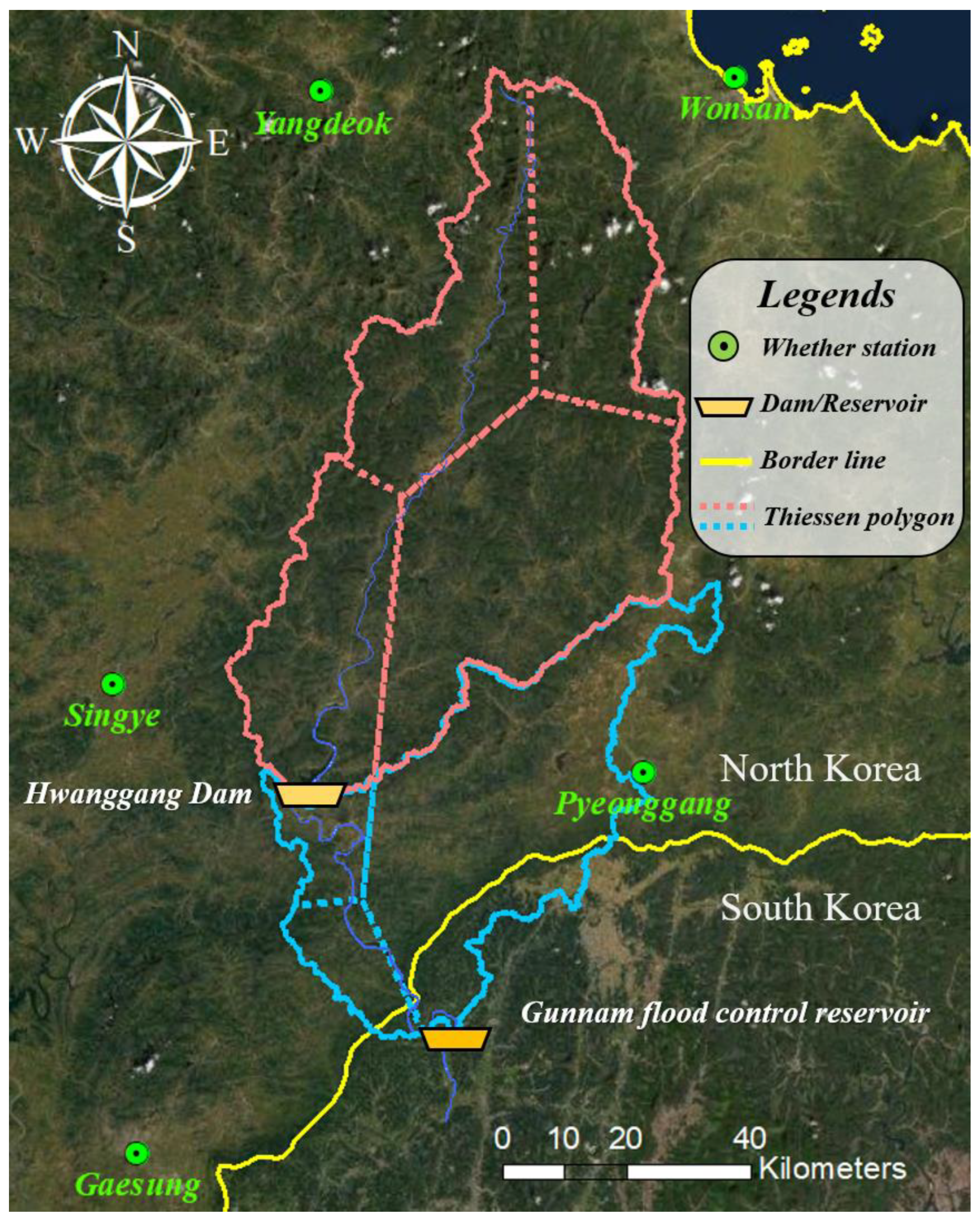
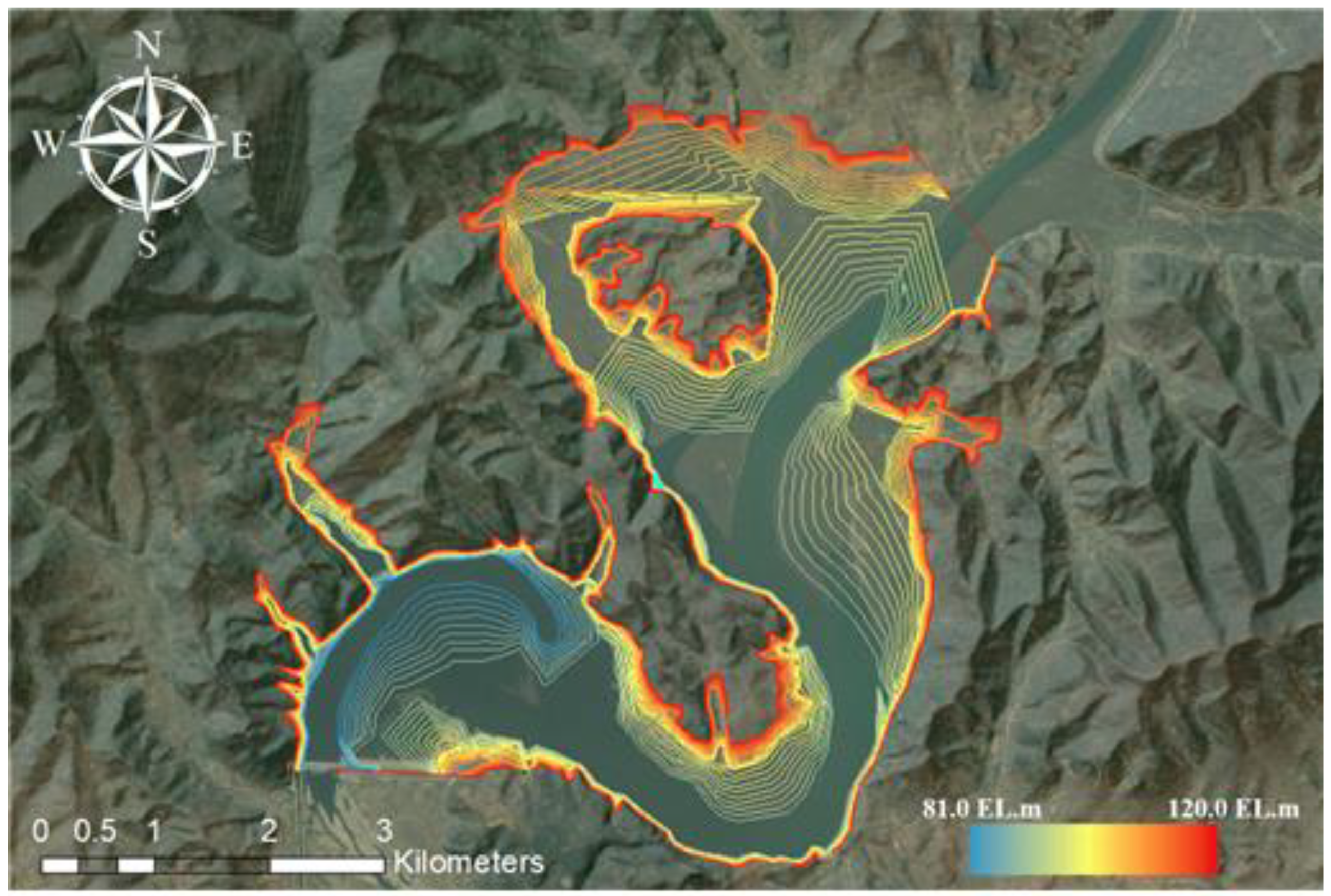
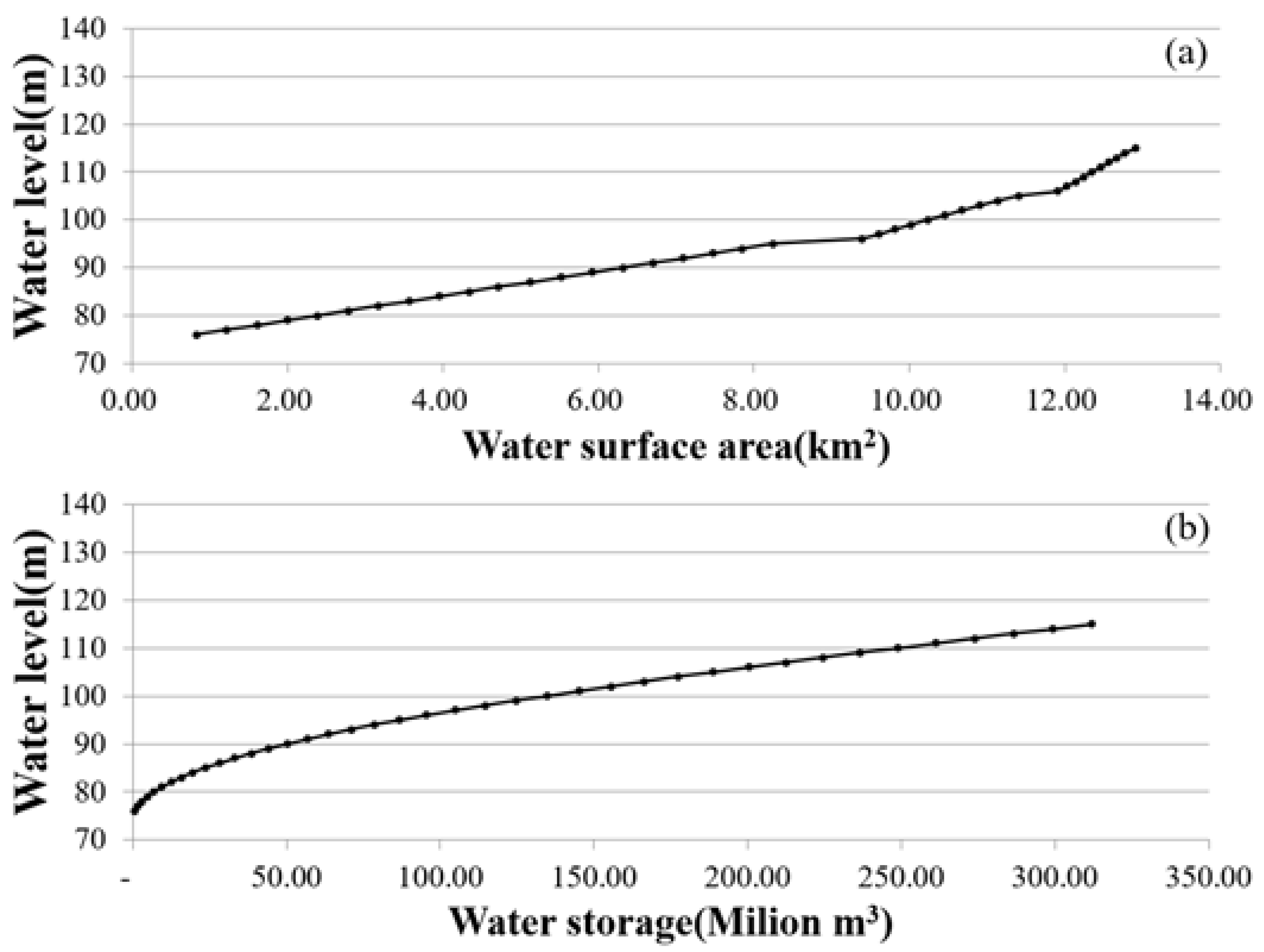

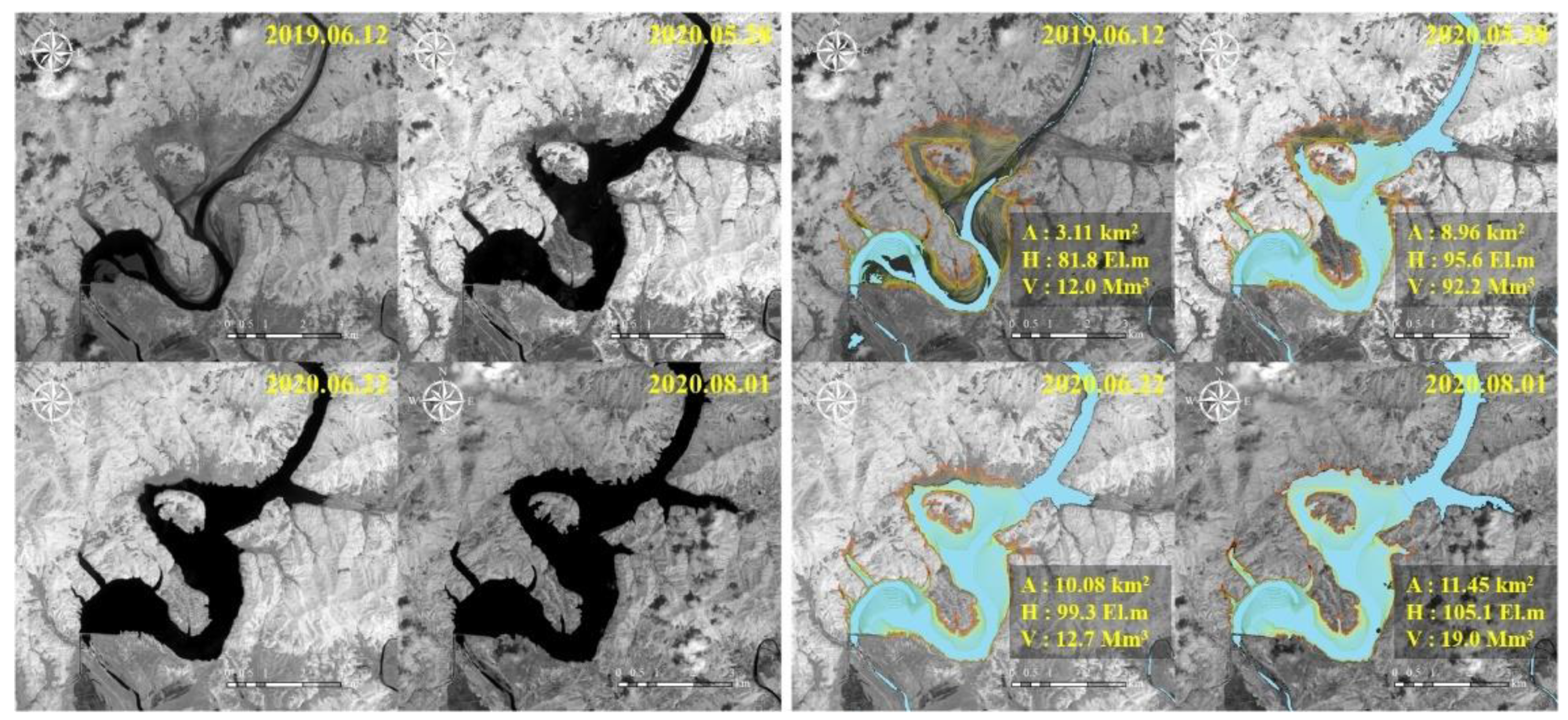




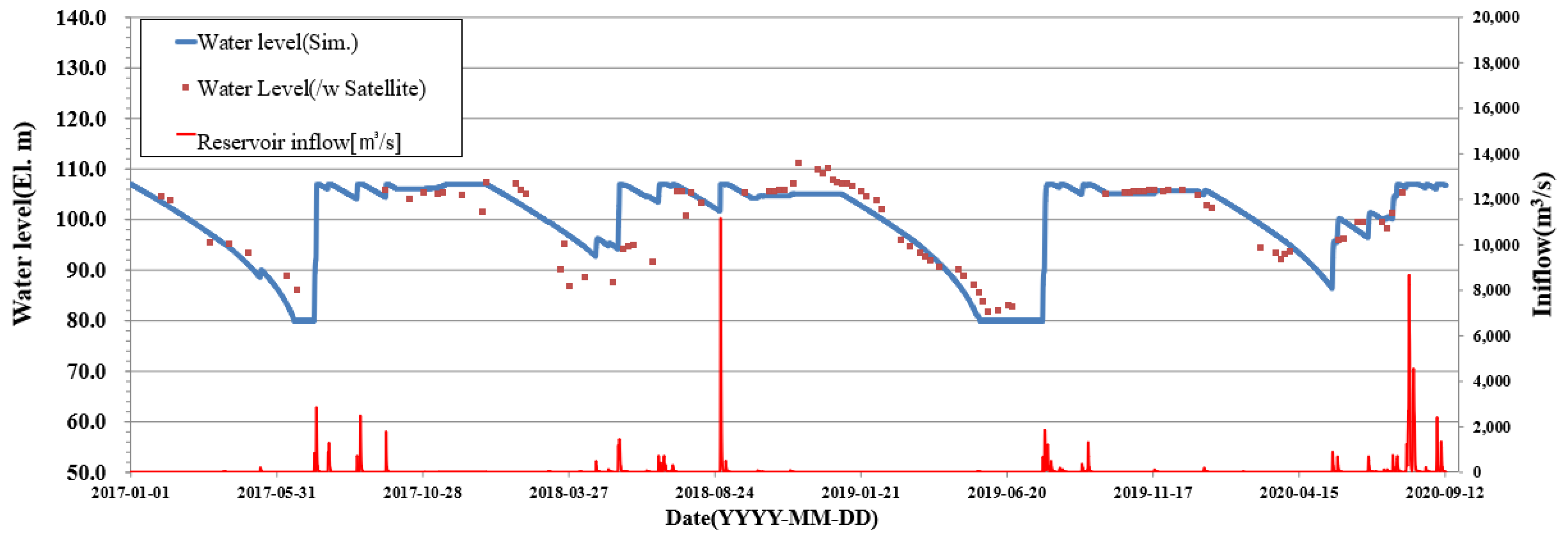

| Location | Yangdeok | Wonsan | Singye | Pyeonggang | Gaesung |
|---|---|---|---|---|---|
| Upstream of Hwanggang Dam | 0.225 | 0.184 | 0.210 | 0.381 | - |
| Downstream of Hwanggang Dam | - | - | 0.099 | 0.787 | 0.114 |
| Sentinel-2 Band | Sentinel-2A | Sentinel-2B | Spatial Resolution (m) | ||
|---|---|---|---|---|---|
| Central Wavelength (nm) | Bandwidth (nm) | Central Wavelength (nm) | Bandwidth (nm) | ||
| Band 3 (Green) | 559.8 | 36 | 559.0 | 36 | 10 |
| Band 8 (NIR) | 832.8 | 106 | 832.9 | 105 | 10 |
| Band 12 (SWIR) | 2202.1 | 175 | 2185.7 | 185 | 20 |
| No. | Basin Name | Area (km2) | River Length (km) | Elevation of the Farthest Point (EL.m) | Elevation of Outlet Point (EL.m) |
|---|---|---|---|---|---|
| 01 | Upstream of Imjin River | 1101.5 | 85.0 | 1285 | 140 |
| 02 | Upstream of Gomitan Stream | 1093.7 | 108.6 | 1086 | 140 |
| 03 | Icheon water level sta. | 666.1 | 57.4 | 714 | 67 |
| 04 | Upstream of Pyeongan Stream | 404.7 | 80.0 | 1086 | 52 |
| 05 | Confluence of Yeockok Stream | 244.8 | 45.3 | 612 | 42 |
| 06 | Lake Bongrae | 498.8 | 73.0 | 491 | 42 |
| 07 | Gumnam Flood Control Reservoir | 183.0 | 21.1 | 326 | 35 |
| No. | Basin Name | Clark Unit Hydrograph | Muskingum Flow Routing | |||
|---|---|---|---|---|---|---|
| Tc (hr) | K (hr) | C0 | C1 | C2 | ||
| 01 | Upstream of Imjin River | 6.60 | 9.21 | 0.0266 | 0.4160 | 0.5575 |
| 02 | Upstream of Gomitan Stream | 8.66 | 11.98 | 0.0162 | 0.4097 | 0.5741 |
| 03 | Icheon water level sta. | 4.84 | 6.79 | 0.0316 | 0.4190 | 0.5494 |
| 04 | Upstream of Pyeongan Stream | 6.30 | 8.64 | 0.0368 | 0.4221 | 0.5412 |
| 05 | Confluence of Yeockok Stream | 3.88 | 5.39 | - | - | - |
| 06 | Lake Bongrae | 6.49 | 8.97 | 0.0303 | 0.4182 | 0.5515 |
| 07 | Gumnam Flood Control Reservoir | 1.99 | 2.84 | - | - | - |
| Parameter | High Water Level | Low Water Level | Constant Release | |
|---|---|---|---|---|
| Nov~Dec | Jan~Oct | |||
| State value | 107.0 EL.m | 80.0 EL.m | 20.0 m3/s | 35.0 m3/s |
| Index | 2017 | 2018 | 2019 | 2020 (~Aug) | Total |
|---|---|---|---|---|---|
| R2 | 0.94 | 0.47 | 0.97 | 0.75 | 0.76 |
| RMSE | 3.07 | 5.81 | 2.25 | 3.18 | 3.97 |
Publisher’s Note: MDPI stays neutral with regard to jurisdictional claims in published maps and institutional affiliations. |
© 2022 by the authors. Licensee MDPI, Basel, Switzerland. This article is an open access article distributed under the terms and conditions of the Creative Commons Attribution (CC BY) license (https://creativecommons.org/licenses/by/4.0/).
Share and Cite
Kim, J.G.; Kang, B.; Kim, S. Flood Inflow Estimation in an Ungauged Simple Serial Cascade of Reservoir System Using Sentinel-2 Multi-Spectral Imageries: A Case Study of Imjin River, South Korea. Remote Sens. 2022, 14, 3699. https://doi.org/10.3390/rs14153699
Kim JG, Kang B, Kim S. Flood Inflow Estimation in an Ungauged Simple Serial Cascade of Reservoir System Using Sentinel-2 Multi-Spectral Imageries: A Case Study of Imjin River, South Korea. Remote Sensing. 2022; 14(15):3699. https://doi.org/10.3390/rs14153699
Chicago/Turabian StyleKim, Jin Gyeom, Boosik Kang, and Sungmo Kim. 2022. "Flood Inflow Estimation in an Ungauged Simple Serial Cascade of Reservoir System Using Sentinel-2 Multi-Spectral Imageries: A Case Study of Imjin River, South Korea" Remote Sensing 14, no. 15: 3699. https://doi.org/10.3390/rs14153699
APA StyleKim, J. G., Kang, B., & Kim, S. (2022). Flood Inflow Estimation in an Ungauged Simple Serial Cascade of Reservoir System Using Sentinel-2 Multi-Spectral Imageries: A Case Study of Imjin River, South Korea. Remote Sensing, 14(15), 3699. https://doi.org/10.3390/rs14153699








